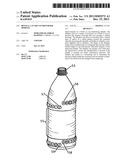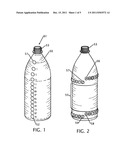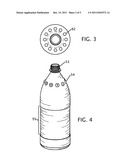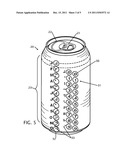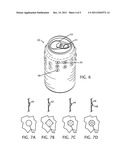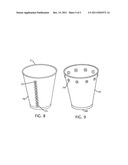Patent application title: BOTTLE, CAN OR CUP IDENTIFIER DIMPLES
Inventors:
Mohammad Ashraf Rajpoot (Corona, CA, US)
IPC8 Class: AB65D2300FI
USPC Class:
2064595
Class name: Special receptacle or package with indicia or area modified for indicia
Publication date: 2011-12-15
Patent application number: 20110303572
Abstract:
Improvements in a bottle or can identifying dimple. The dimples exist in
a variety of locations on a bottle or can to increase the number of
people that can consume a similar beverage. The dimples can exist in
concentric lines, vertical lines or and/or in a spiral pattern around the
container whereby increasing the quantity of dimples to include a
complete alphabet and or numbers. The shape of the dimples ranges from
rounded domes to triangular tips and also multi-faceted shapes to provide
greater structural integrity to the depressed dimple. The dimples can
change color when they are depressed to ensure the identification is
present if the dimple is pushed out under carbonation pressure. The
dimples are usable as a measuring tool to determine the amount of fluid
within the container and are useable to determine if the fluid level has
changed from tampering.Claims:
1. A bottle with identifying dimples comprising: a plastic beverage
container; said plastic beverage container further having a plurality of
dimples that protrude outward from an outer circumferential wall of said
plastic beverage container; said dimples being operable by a user to
identify ownership of said plastic bottle, and said plurality of dimples
exists in a vertical and or tangential arrangement on said plastic
beverage container.
2. The bottle with identifying dimples according to claim 1 wherein said dimples correspond to a complete set of alphabetical characters.
3. The bottle with identifying dimples according to claim 1 wherein said plurality of dimples correspond to at least two complete sets of numbers from zero to 9.
4. The bottle with identifying dimples according to claim 1 wherein said plurality of dimples correspond to at least four complete sets of number from zero to 9 to allow said ownership in a four digit numerical value or date.
5. The bottle with identifying dimples according to claim 1 wherein said dimples are dome shaped, diamond shaped, hexagonal shaped or octagonal shaped.
6. The bottle with identifying dimples according to claim 1 wherein said dimples change color from being stressed when said dimples are depressed.
7. The bottle with identifying dimples according to claim 1 wherein said dimples correspond to the volume remaining or used from within said bottle.
8. A can with identifying dimple comprising: a can beverage container; said can beverage container further having a plurality of dimples that protrude outward from an outer circumferential wall of said can beverage container; said dimples configures with multiple repeating patters of dimples further having indicia to indentify said indicia with a corresponding dimple; said dimples being operable by a user to identify ownership of said can beverage container, and said plurality of dimples exists in a vertical and or tangential arrangement on said can beverage container.
9. The can with identifying dimples according to claim 8 wherein said plurality of dimples corresponds to two complete set of alphabetical characters.
10. The can with identifying dimples according to claim 8 wherein said plurality of dimples correspond to at least two complete sets of numbers from zero to 9.
11. The can with identifying dimples according to claim 8 wherein said plurality of dimples correspond to at least four complete sets of number from zero to 9 to allow said ownership in a four digit numerical value or date.
12. The can with identifying dimples according to claim 8 wherein said dimples are dome shaped, diamond shaped, hexagonal shaped or octagonal shaped.
13. The can with identifying dimples according to claim 8 wherein said dimples change color from being stressed when said dimples are depressed.
14. The can with identifying dimples according to claim 8 wherein said dimples correspond to the volume remaining or used from within said bottle.
15. A drinking cup with identifying dimples comprising: a plastic or paper cup; said plastic or paper cup further having a plurality of dimples that protrude outward from an outer circumferential wall of said plastic or paper cup container; said dimples being operable by a user to identify ownership of said plastic or paper cup, and said plurality of dimples exists in a vertical and or tangential arrangement on said plastic or paper cup.
16. The drinking cup with identifying dimples according to claim 15 wherein said dimples correspond to a complete set of alphabetical characters.
17. The drinking cup with identifying dimples according to claim 15 wherein said plurality of dimples corresponds to at least two complete sets of numbers from zero to 9.
18. The drinking cup with identifying dimples according to claim 15 wherein said dimples are dome shaped, diamond shaped, hexagonal shaped or octagonal shaped.
19. The drinking cup with identifying dimples according to claim 15 wherein said dimples change color from being stressed when said dimples are depressed.
20. The drinking cup with identifying dimples according to claim 15 wherein said dimples correspond to the volume remaining or used from within said bottle.
Description:
CROSS REFERENCE TO RELATED APPLICATION
[0001] Not Applicable
STATEMENT REGARDING FEDERALLY SPONSORED RESEARCH OR DEVELOPMENT
[0002] Not Applicable
THE NAMES OF THE PARTIES TO A JOINT RESEARCH AGREEMENT
[0003] Not Applicable
INCORPORATION-BY-REFERENCE OF MATERIAL SUBMITTED ON A COMPACT DISC
[0004] Not Applicable
BACKGROUND OF THE INVENTION
[0005] 1. Field of the Invention
[0006] This invention relates to improvements in identification and marking system for plastic bottles. More particularly, the present invention includes a plurality of raised dimples that are formed in the outer surface skin of a plastic bottle.
[0007] 2. Description of Related Art Including Information Disclosed Under 37 CFR 1.97 and 1.98
[0008] Several products and patents have been issued that cover identification systems for identifying the owner of a bottle. Typically when multiple people gather the same brand of refreshment is used for some or all of the people. Generally all of the bottles appear the same and if multiple people place the bottle down the ownership of the bottle is difficult. Another similar problem exists when the amount of fluid that is in a bottle is consumed or measured. In order to identify the level of fluid within the bottle that is consumed or measure there needs to be some marking system that is difficult to tamper. Exemplary examples of patents covering these improvements are disclosed herein.
[0009] U.S. Pat. No. 4,877,119 issued Oct. 31, 1989 to Jeannette T. Hosking and U.S. Pat. No. 5,839,581 issued Nov. 24, 1998 to Douglas Vagedes both disclose drinking containers where the lid can be rotated or placed a different orientations to identify particular indicia that is marked on the side for a cup. While these patents disclose an identification system for drinking containers these patents only work with the cap on a cup and further require two components, i.e. the cup and the lid. These patents also do not prevent or identify tampering or the amount of fluid that is consumed.
[0010] U.S. Pat. No. 6,237,269 issued May 29, 2001 to Stephen M. Key discloses a roll-fed method for constructing a rotatable label system. The label is fabricated to wrap around a plastic bottle. The label includes a plurality of indicia that is rotated to indicate a unique letter for each person drinking a specific bottle. While this patent allows for placing an identifier to each bottle the identifier can be altered. The marking system also is not usable to identify the amount of fluid within the container and further does not provide information about the tampering or altering of the user.
[0011] U.S. Pat. No. 6,244,456 issued Jun. 12, 2001 to Dennis J. Hanlon discloses an identifiable beverage container. The identifiable beverage container has dimples that exist around the container or in a vertical arrangement on the can. Because the can is not transparent the amount of fluid within the container can't be determined. The markings do not change color to reduce the potential for tampering. In '446 the markings only exist in a vertical or horizontal orientation whereas in the pending application the markings can exist in a spiral orientation to provide a higher resolution of marking and a higher number of markings to accommodate a greater number of guests at a party.
[0012] What is needed is a user marking system for a bottle that can accommodate a high number of consumers, provides for consumption/use marking system and color tainting system to reduce tampering of the marks. This application provides those functions.
BRIEF SUMMARY OF THE INVENTION
[0013] It is an object of the bottle or can identifier dimples for the dimples to exist in a variety of locations on a bottle or can. One or multiple rows of dimples can be placed on a bottle to increase the number of people that can consume a similar beverage. The markings can exist in concentric lines on the container or vertically along a side of the beverage container. The dimples can also exist in a spiral pattern around the container whereby increasing the quantity of dimples to include a complete alphabet and or numbers. The dimples can also be used by a blind or sight impaired person or in a dark club or room where a person can feel the dimples like brail symbols to determine the identity of their bottle.
[0014] It is another object of the bottle or can identifier dimples for the dimples to be formed in a variety of shapes from rounded domes to triangular tips and also multi-faceted shapes. Some of the contemplated shapes provide greater structural integrity to the depressed dimple. The greater structural integrity increases retention of the shape if a cap is placed onto a bottle and the bottle is pressurized. A simple dome shape could easily be pushed out under carbonation pressure whereby eliminating the identification.
[0015] It is another object of the bottle or can identifier dimples for the dimples to change color when they are depressed. The color change can be produced from stressing the material when the dimple(s) are depressed or from material that is placed onto the dimple areas after the forming process of the bottle. The color change is particularly important with a plastic bottle that can be re-pressurized from carbonation whereby pushing out any depressed dimples. The color change can be the same for all of the dimples or can be different depending upon the location of the dimples on the container.
[0016] It is still another object of the bottle or can identifier dimples for the dimples to be useful to determine the amount of fluid within the container. A spiral confirmation of dimples around a bottle can be used for a number of other purposes to identify the amount of fluid that is within, or has been used from a container. This is useful as a measuring tool for dispensing fluid from the container and can also be used to determine if the fluid level has been changed from tampering. As a measuring device the dimpled markings can be in ounces Milliliters or shots.
[0017] Various objects, features, aspects, and advantages of the present invention will become more apparent from the following detailed description of preferred embodiments of the invention, along with the accompanying drawings in which like numerals represent like components.
BRIEF DESCRIPTION OF THE SEVERAL VIEWS OF THE DRAWING(S)
[0018] FIG. 1 shows a front view of a plastic bottle with the dimples placed vertically on one side of the bottle.
[0019] FIG. 2 shows a front view of a plastic bottle with the dimples placed around the circumference of the bottle.
[0020] FIG. 3 shows a top view of a plastic bottle with the dimples placed around the top circumference of the bottle.
[0021] FIG. 4 shows a perspective view of a plastic bottle with two sets of alphabet labeled dimples extending in a spiral orientation around the bottle.
[0022] FIG. 5 shows a top perspective view of a soda type can with the identifying dimples placed in a staggered arrangement of the can.
[0023] FIG. 6 shows a perspective view of the soda can with alphabetical dimples extending in a spiral orientation around the can.
[0024] FIG. 7A-D shows a number of different shapes of dimples that are contemplated.
[0025] FIG. 8 shows a front view of a plastic or paper cup with the dimples placed vertically on one side of the cup.
[0026] FIG. 9 shows a front view of plastic or paper cup with the dimples placed around the circumference of the cup.
DETAILED DESCRIPTION OF THE INVENTION
[0027] FIG. 1 shows a front view of a plastic bottle 50 with the dimples placed vertically on one side of the bottle. FIG. 2 shows a perspective view of a plastic bottle 50 with two sets of alphabet labeled dimples extending in a spiral orientation around the bottle. FIG. 3 shows a top view of a plastic bottle with the dimples placed around the top circumference of the bottle. FIG. 4 shows a front view of a plastic bottle with the dimples placed around the circumference of the bottle. All of the bottles shown have a threaded top portion 53 for a cap to be secured. The contents of the bottle 50 is consumed or poured from the top opening 61. While these bottles are shown as plastic type bottles, it is also contemplated that the bottles can be made of aluminum.
[0028] In FIG. 1 the markings are placed to provide not only unique identifiers for different owners' of the bottle 50, but also to provide an indicator for the volume that remains within the bottle 50. The dimples 51 are placed in a vertical column with markings from 1 to 14. This would signify a bottle with 14 ounces of fluid where the bottom dimple 52 signifies one ounce remaining within the bottle and the top dimple 51 would signify a full bottle with 14 ounces. It is further contemplated that the dimples could exist in a spiral pattern around the bottle to provide a higher resolution for the contents within the bottle. In the embodiment shown in FIG. 4 the markings are shown as ounces it is also contemplated that the markings can identify Milliliters, shots or other markings.
[0029] In FIG. 2 two spiral rows of alphabetical dimples are shown starting with the letter "A" 56, 58 and ending with the letter "Z" 57, 59. These two rows are shown in a spiral orientation, but could also be formed in a row orientation. The letters are shown above and below the label area 55. In this figure the letters "C" and "Y" have been depressed and these dimples are shown colored to indicate that they have been altered. The coloring is from stresses placed on the dimples. If the bottle is later closed and pressurized, these dimples can push back out, but the coloring would remain with the dimples.
[0030] In FIG. 2 there are twelve dimples 62 with indicia near each dimple that signifies a particular month. In FIG. 4 there are ten dimples 54 placed around the tapered neck of the bottle. Placement of the dimples in this location allows the central area 55 of the bottle to be clear for placement of a label. While only one row of dimples 54 is shown it is contemplated that multiple rows of two, four or more rows can be used based upon the available area.
[0031] At a party or other gathering a number of people may mistakenly select the same number. Most notably number one. To minimize confusion, multiple rows of repeating numbers are used. These repeating rows of dimples allow a person to enter a number, date or combination into the dimples. In FIG. 5 vertical columns 32 are used with ten horizontal rows 31. This allows for a total of 30 different dimples 30 that can be depressed. Using the dimples in combination for a birth date for month and year or month and date. A total of about 1,200 combinations are contemplated. The dimples are formed into the sides or rim of the can 20. The numbers or letters can be written either inside or outside of the dimple. The dimples can be used by a blind or sight impaired person or in a dark club or room where a person can feel the dimples like brail symbols to determine the identity of their uniquely marked bottle.
[0032] When the dimples are depressed a person can tell by visualizing the indented code and can also feel the depressed dimples. It is further contemplated that a user can depress the dimples 30 in sequence to identify or approximate the amount of fluid they have consumed. This is particularly important at a party where there exists a possibility that additional or undesirable fluid is added to an unattended can. FIG. 1 shows the dimples being used to identify the amount of fluid within the container. Because dimples in aluminum cans can be pushed back out of the can by simply inserting a finger or other object through the drinking hole 22 it is contemplated that the structure of the dimples provide a visual indictor that the dimples have been pushed back out. This can be accomplished by using folds in the dimples as shown and described in FIG. 7 or by coating the dimples with a material that breaks or shows stress when the dimples are depressed.
[0033] FIG. 5 shows a top perspective view of a soda type can with the identifying dimples placed in a staggered arrangement of the can 20. This arrangement shows a more artistic configuration of the dimples 30. In this configuration the dimples 30 are arranged in four columns 32 with ten rows 31 of angled or slanted dimples on the vertical wall 23. The top of the can includes a standard type pull and retain tab 21 that opens the top of the can 20 to allow the internal beverage to be consumed though the opening 22. With all of the dimples existing on one side of the can 20 there is still sufficient room for labeling of the can. The brail dots 33 are shown on or near the dimples 30.
[0034] FIG. 6 shows a perspective view of the soda can with alphabetical dimples extending in a spiral orientation around the can 20. In this embodiment a total of 26 dimples are shown starting with the beginning of the American alphabet "A" 35 and continuing to the last letter of the alphabet "X" 36. The letters are placed in a spiral orientation around the can 20 starting in the bend of the vertical side wall of the can 20. The spiral orientation allows for a substantial number of additional letters that. It is further contemplated that the spiral orientation can include both letters and numbers. While the dimples are shown in FIGS. 1-6 at various locations on the can it is contemplated that the location is variable based upon manufacturing and design choice.
[0035] FIG. 7 A-D shows a number of different shapes of dimples that are contemplated. Each configuration shows an outside view (below) with a cross sectional view (above). In FIG. 7A the outside view shows the dimple 41 as round, and the cross sectional view shows a smooth dome 40. This configuration is the most common but provides limited structural integrity to retain the dimple when pressure is exerted from the inside of the drinking container. In FIGS. 1-4 a bottle with a top closure is shown. Typically a user might close or cap a bottle of soda to retain carbonation within the bottle. The carbonation can push the dimples or domes out whereby defeating one purpose of the identification system. Some plastic materials change color or whiten when they are structurally altered. In the preferred embodiment of the bottles the bottles are made from material that changes color when they are structurally stressed. This ensures that once dimple(s) are depressed they show a mark for future reference.
[0036] In the dimples shown in FIG. 7B the dimple is shown as a diamond, rectangular or square 43 in the outside view with a raised central point. That is visible in the side sectional view 42. When depressed, the raised point adds structural strength to retain the dimple in the depressed condition. In FIG. 7C the dimple is shown as a hexagon 45 with a pointed tip 44 that provides similar structural strength as described for FIG. 3B. FIG. 7D shows the dimple as an octagon pattern 47 where the top of the dome 46 is flattened 48. The flat top also provides structural support to reduce the possibility that the dome will be pushed out under the pressure of carbonation within the bottle. While only four different configurations of dimples are shown and described, various other shapes are contemplated including but not limited to triangular, pentagonal, bars and others.
[0037] FIG. 8 shows a front view of a plastic or paper cup with the dimples placed vertically numbering "0" 72 to "9" 73 on one side of the cup. FIG. 9 shows a front view of plastic or paper cup with the dimples 74 placed around the circumference of the cup. These cups show the dimples in different orientations, but the function is similar to previously disclosed herein. The cup 70 has a rolled or enlarged lip 71 where a user drinks from and a base 69. It is further contemplated that the plastic or paper cups include multiple rows or columns of numbers and or letters as previously disclosed herein to support a larger number of users.
[0038] Thus, specific embodiments of a bottle or can identifier dimple(s) have been disclosed. It should be apparent, however, to those skilled in the art that many more modifications besides those described are possible without departing from the inventive concepts herein. The inventive subject matter, therefore, is not to be restricted except in the spirit of the appended claims.
User Contributions:
Comment about this patent or add new information about this topic:
| People who visited this patent also read: | |
| Patent application number | Title |
|---|---|
| 20120149127 | SAMPLE ANALYZER AND SAMPLE ANALYZING METHOD |
| 20120149126 | Fluidics Apparatus and Fluidics Substrate |
| 20120149125 | Ion Population Control for an Electrical Discharge Ionization Source |
| 20120149124 | DEVICE FOR COLLECTION AND ASSAY OF ORAL FLUIDS |
| 20120149123 | Low Temperature Method to Enhance Detection of Magnetic Beads |

